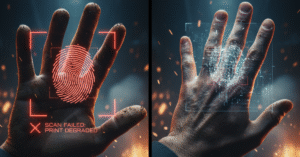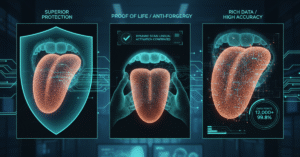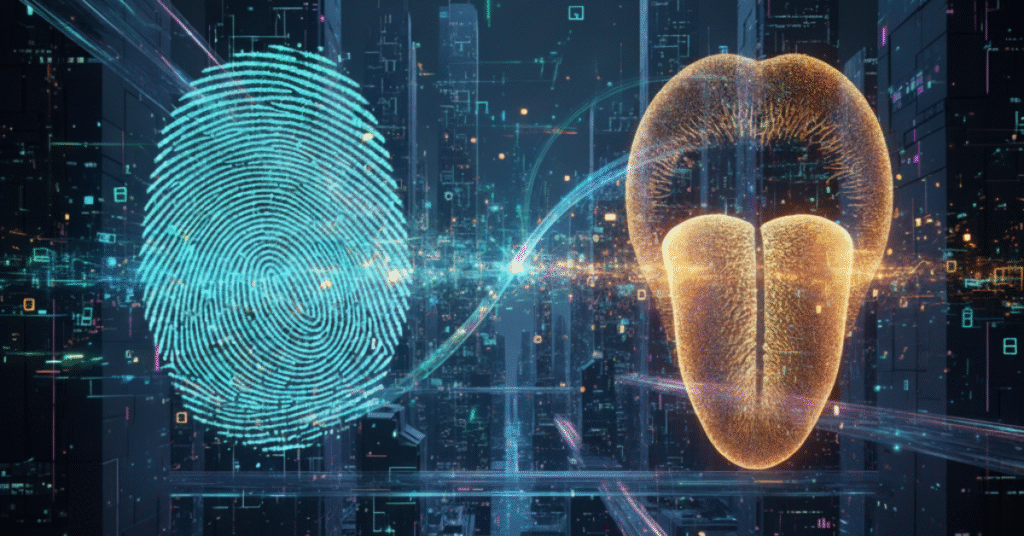Tongue print vs fingerprint for personal identification—my recent research into biometrics led me to an absolutely mind-blowing discovery. This is a fact that might change how we think about personal security forever.
The fingerprint has been the gold standard for over a century. However, a question now arises: What if there is something even more unique, more stable, and harder to forge hidden right inside your mouth?
Let’s dive into the fascinating comparison and explore why your tongue might just be the future of security. My personal journey to uncover the ultimate biometric led me directly to the core debate: tongue print vs fingerprint for personal identification.
The Problem with the Classic: The Fingerprint
In the realm of security, the long-term effectiveness of the fingerprint is being rigorously tested against newer, more stable methods.
We have all, at some point, pressed our finger onto an inkpad or a scanner. Fingerprints work because of the universally accepted principle of uniqueness—no two people share the exact same pattern.
Yet, the fingerprint is not perfect. This is where my personal concern about current security reliance begins.
Think about the life of a construction worker, a chef, or anyone who frequently uses their hands for manual labor. Over time, their fingerprints can be worn down, scarred, or temporarily damaged by cuts or chemicals.
In forensic science, mutilated or burned fingers are a significant challenge. If a key part of your identity can be accidentally erased or altered, then our heavy reliance on it is inherently risky.

Unlocking the Secret Biometric: Your Unique Tongue Print
The idea that your tongue holds a unique signature is one of the most exciting facts I’ve come across. It’s an intriguing concept and one of the 3 incredible facts we need to understand.
The tongue print, or lingual impression, refers to the distinct patterns, textures (like papillae and fissures), shape, and colour characteristics of the dorsal (top) surface of the tongue.
Just like fingerprints, no two tongues are exactly alike. This fact holds true even for identical twins, making the tongue a highly reliable identifier.
It sounds bizarre, but the tongue offers superior qualities compared to its more famous counterpart. Researchers are increasingly turning their attention to this organ.
In fact, the scientific consensus is rapidly shifting toward the potential of the tongue in the ongoing debate of tongue print vs fingerprint for personal identification.
The 3 Incredible Facts Favoring the Tongue in Biometrics
When comparing the tongue print vs fingerprint for personal identification, the tongue consistently shows powerful advantages that are driving its adoption in high-security research.

Fact 1: Superior Protection and Stability
The tongue is an internal organ, shielded inside the oral cavity. This provides perhaps the best natural protection possible. Unlike a fingerprint, which is constantly exposed, the tongue is protected from cuts and wear. This makes its unique identifying features highly durable over time. Studies show that the tongue’s texture remains remarkably stable throughout a person’s life.
Fact 2: Proof of Life and Anti-Forgery
For a tongue print to be captured, the individual must be able to voluntarily protrude their tongue. This dynamic action serves as an excellent “Proof of Life” indicator—a feature crucial for high-security access controls. Furthermore, forging a tongue print is vastly more difficult than forging a fingerprint due to the tongue’s complex 3D shape and moisture level.
Fact 3: Rich Data and High Accuracy
The tongue offers a larger and more complex surface area compared to a single fingertip. This allows for the extraction of a richer set of data points, potentially leading to even more precise identification accuracy than traditional dactyloscopy (fingerprint analysis). The reliability of tongue print vs fingerprint for personal identification is truly changing the security debate.
Tongue Print vs Other High-Security Biometrics
It is crucial to note that high-security systems often rely on Iris Scans due to their extreme accuracy and stability. This biometric is considered the current gold standard. However, the iris can be affected by certain medical conditions and requires specialized, sometimes intrusive, infrared scanning.
In contrast, the tongue offers unique advantages. It remains an internal organ protected from all external light and environmental exposure. This makes its unique identifying features arguably even more stable and consistently reliable than those in the eye.
The Biometric Future: Integration, Not Replacement
When considering future high-stakes identification protocols, the stability of the tongue print offers compelling advantages over traditional methods.
Moving forward, every modern security expert must evaluate the future role of the tongue in the context of tongue print vs fingerprint for personal identification.
So, will our tongues immediately replace our fingers at the security checkpoint? Not yet. While the science strongly supports the uniqueness and stability of the tongue print, there are still technical hurdles to overcome in mass implementation.

The primary challenge lies in developing standardized, non-invasive, and high-resolution scanning devices. The tongue is a flexible, wet organ, and slight variations in the way it’s protruded can currently affect the scan results.
However, the potential is undeniable. Researchers are actively working on advanced image processing and AI-based analysis to make tongue print recognition a fast and reliable reality. The future of high-level security may not be a simple touch, but a quick scan, possibly even combining both biometrics for the highest level of assurance.
Ultimately, whether used as a standalone tool or a secondary verification method, the knowledge that an absolutely unique identifier exists hidden in our mouth solidifies the fact that the human body is the most sophisticated security system ever built.

